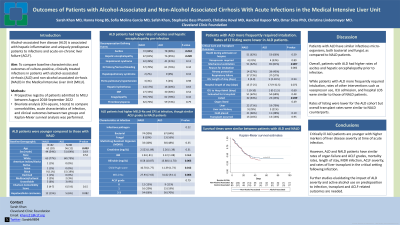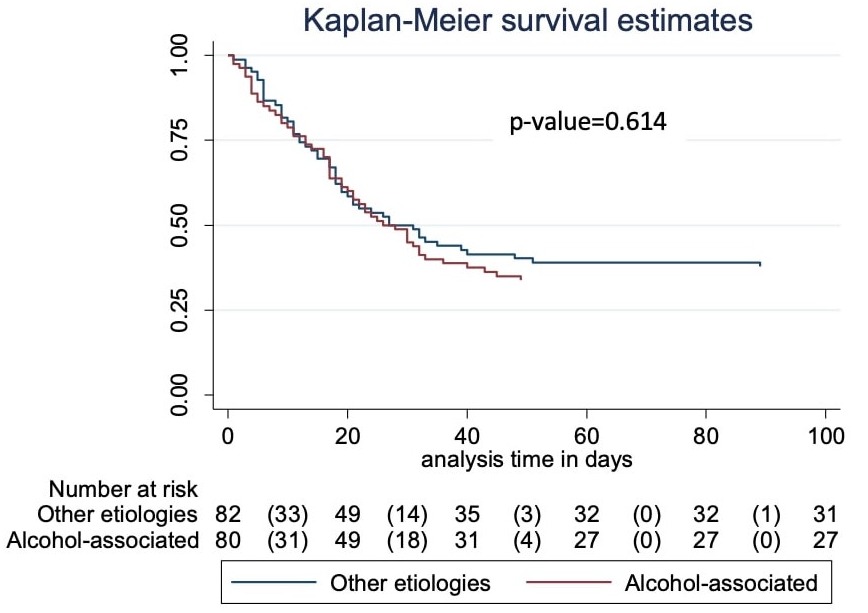Monday Poster Session
Category: Liver
P2370 - Comparative Outcomes of Patients With Alcohol-Associated and Non-Alcohol-Associated Cirrhosis With Acute Infections in the Medical Intensive Liver Unit
Monday, October 23, 2023
10:30 AM - 4:15 PM PT
Location: Exhibit Hall

.jpg)
Sarah Khan, MD
Cleveland Clinic Foundation
Cleveland, OH
Presenting Author(s)
Sarah Khan, MD1, Hanna Hong, BS2, Sofia Molina Garcia, MD3, Stephanie Bass, PharmD1, Safah Khan, 4, Christine Koval, MD1, Aanchal Kapoor, MD1, Omar Sims, PhD1, Christina C. Lindenmeyer, MD1
1Cleveland Clinic Foundation, Cleveland, OH; 2Cleveland Clinic Lerner College of Medicine, Cleveland, OH; 3Cleveland Clinic, Cleveland, OH; 4Weill Cornell Medicine-Qatar, Doha, Ad Dawhah, Qatar
Introduction: Alcohol-associated liver disease is associated with hepatic inflammation and uniquely predisposes patients to infections and associated acute-on-chronic liver failure (ACLF). Alcohol use is among the leading causes of ACLF and associated mortality in the critical care setting. We aimed to compare baseline characteristics and outcomes of infections in patients with alcohol-associated cirrhosis (ALD) and non-alcohol associated cirrhosis (NALD) in the Medical Intensive Liver Unit (MILU).
Methods: From our prospective registry of patients admitted to our MILU between August 2018-September 2022, we identified 80 culture-positive patients with ALD and 82 with NALD. Chi-squared and t-tests were used to compare the two groups on comorbidities, acute characteristics of infection, and clinical outcomes.
Results: Compared to NALD patients, patients with ALD were younger (56 years vs 61 years, p=0.003) and had higher rates of pre-infection ascites and hepatic encephalopathy (98% vs 88%, p=0.018; 95% vs 82%, p=0.009 respectively) (Table 1). The majority of infections were bacterial (87%) (Enterococcus faecium, Escherichia coli, and Klebsiella spp) followed by fungal (13%) (Candida). Rates of fungal infections and multi-drug resistant (MDR) infections were similar between patient groups. At time of infection, bilirubin (13.88 vs 8.58, p=0.003), MELD-Na (31.62 vs 27.92, p=0.006) and Child Pugh scores (11.39 vs 10.70, p=0.012) were significantly higher in ALD patients; degree of ACLF severity was similar between patient groups. ALD patients more frequently required intubation (81% vs 62%, p=0.007), but had similar rates of vasopressor requirements, ICU, and hospital LOS. Rates of listing for liver transplant (LT) were lower in ALD patients (43% vs 63%, p=0.039), while rates of LT among listed patients and in-hospital mortality were similar. The two groups did not differ in survival (figure 1).
Discussion: Critically ill ALD patients are younger with higher markers of liver disease severity at time of acute infection but have similar rates of organ failure or ACLF grade, and comparable outcomes of mortality, LOS, MDR infection, ACLF severity, and rates of LT as NALD patients in the critical setting following infection. Future studies elucidating the impact of ALD severity and active alcohol use on predisposition to infection and ACLF-related outcomes are needed.

Disclosures:
Sarah Khan, MD1, Hanna Hong, BS2, Sofia Molina Garcia, MD3, Stephanie Bass, PharmD1, Safah Khan, 4, Christine Koval, MD1, Aanchal Kapoor, MD1, Omar Sims, PhD1, Christina C. Lindenmeyer, MD1. P2370 - Comparative Outcomes of Patients With Alcohol-Associated and Non-Alcohol-Associated Cirrhosis With Acute Infections in the Medical Intensive Liver Unit, ACG 2023 Annual Scientific Meeting Abstracts. Vancouver, BC, Canada: American College of Gastroenterology.
1Cleveland Clinic Foundation, Cleveland, OH; 2Cleveland Clinic Lerner College of Medicine, Cleveland, OH; 3Cleveland Clinic, Cleveland, OH; 4Weill Cornell Medicine-Qatar, Doha, Ad Dawhah, Qatar
Introduction: Alcohol-associated liver disease is associated with hepatic inflammation and uniquely predisposes patients to infections and associated acute-on-chronic liver failure (ACLF). Alcohol use is among the leading causes of ACLF and associated mortality in the critical care setting. We aimed to compare baseline characteristics and outcomes of infections in patients with alcohol-associated cirrhosis (ALD) and non-alcohol associated cirrhosis (NALD) in the Medical Intensive Liver Unit (MILU).
Methods: From our prospective registry of patients admitted to our MILU between August 2018-September 2022, we identified 80 culture-positive patients with ALD and 82 with NALD. Chi-squared and t-tests were used to compare the two groups on comorbidities, acute characteristics of infection, and clinical outcomes.
Results: Compared to NALD patients, patients with ALD were younger (56 years vs 61 years, p=0.003) and had higher rates of pre-infection ascites and hepatic encephalopathy (98% vs 88%, p=0.018; 95% vs 82%, p=0.009 respectively) (Table 1). The majority of infections were bacterial (87%) (Enterococcus faecium, Escherichia coli, and Klebsiella spp) followed by fungal (13%) (Candida). Rates of fungal infections and multi-drug resistant (MDR) infections were similar between patient groups. At time of infection, bilirubin (13.88 vs 8.58, p=0.003), MELD-Na (31.62 vs 27.92, p=0.006) and Child Pugh scores (11.39 vs 10.70, p=0.012) were significantly higher in ALD patients; degree of ACLF severity was similar between patient groups. ALD patients more frequently required intubation (81% vs 62%, p=0.007), but had similar rates of vasopressor requirements, ICU, and hospital LOS. Rates of listing for liver transplant (LT) were lower in ALD patients (43% vs 63%, p=0.039), while rates of LT among listed patients and in-hospital mortality were similar. The two groups did not differ in survival (figure 1).
Discussion: Critically ill ALD patients are younger with higher markers of liver disease severity at time of acute infection but have similar rates of organ failure or ACLF grade, and comparable outcomes of mortality, LOS, MDR infection, ACLF severity, and rates of LT as NALD patients in the critical setting following infection. Future studies elucidating the impact of ALD severity and active alcohol use on predisposition to infection and ACLF-related outcomes are needed.

Figure: Figure 1. Comparison of Survival Between Patients with ALD and non-ALD Cirrhosis With Infections
Disclosures:
Sarah Khan indicated no relevant financial relationships.
Hanna Hong indicated no relevant financial relationships.
Sofia Molina Garcia indicated no relevant financial relationships.
Stephanie Bass indicated no relevant financial relationships.
Safah Khan indicated no relevant financial relationships.
Christine Koval indicated no relevant financial relationships.
Aanchal Kapoor indicated no relevant financial relationships.
Omar Sims indicated no relevant financial relationships.
Christina Lindenmeyer: Merck – Chapter Author for Merck Manuals.
Sarah Khan, MD1, Hanna Hong, BS2, Sofia Molina Garcia, MD3, Stephanie Bass, PharmD1, Safah Khan, 4, Christine Koval, MD1, Aanchal Kapoor, MD1, Omar Sims, PhD1, Christina C. Lindenmeyer, MD1. P2370 - Comparative Outcomes of Patients With Alcohol-Associated and Non-Alcohol-Associated Cirrhosis With Acute Infections in the Medical Intensive Liver Unit, ACG 2023 Annual Scientific Meeting Abstracts. Vancouver, BC, Canada: American College of Gastroenterology.
